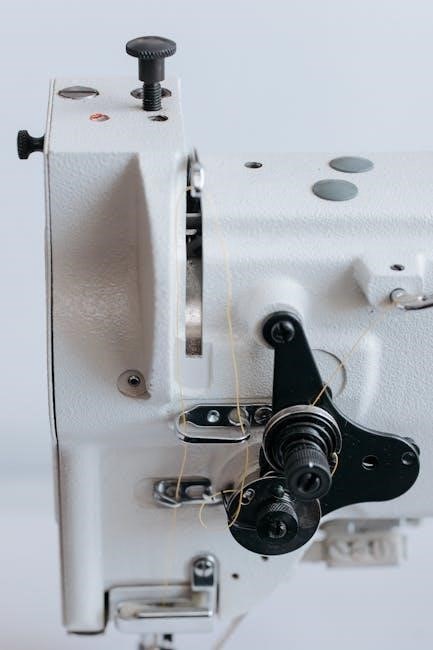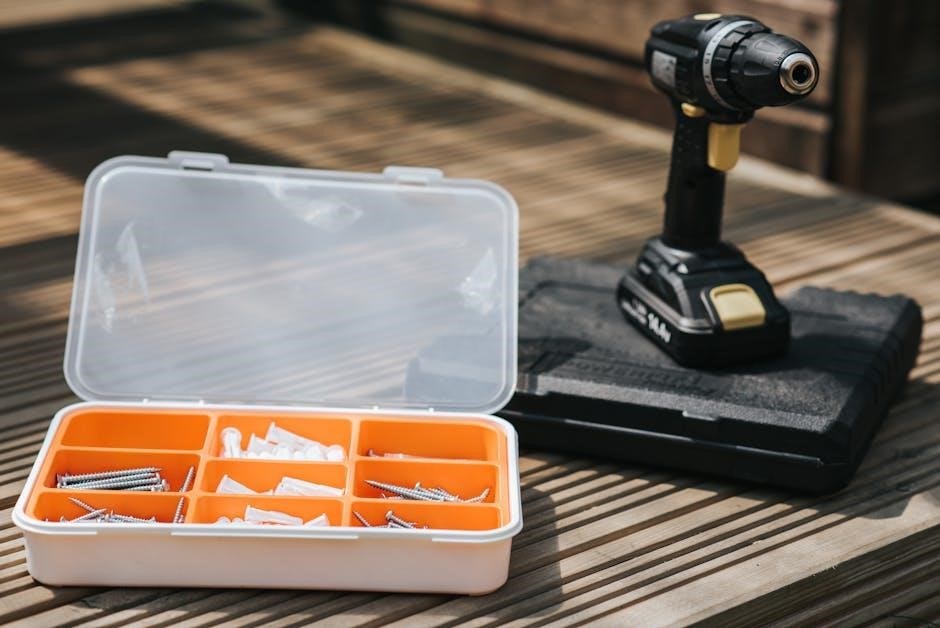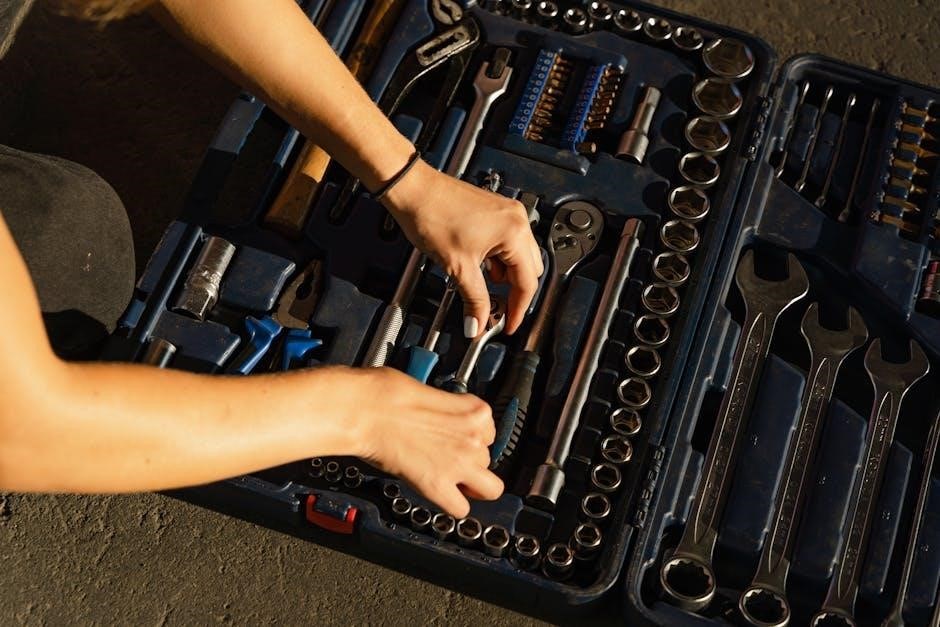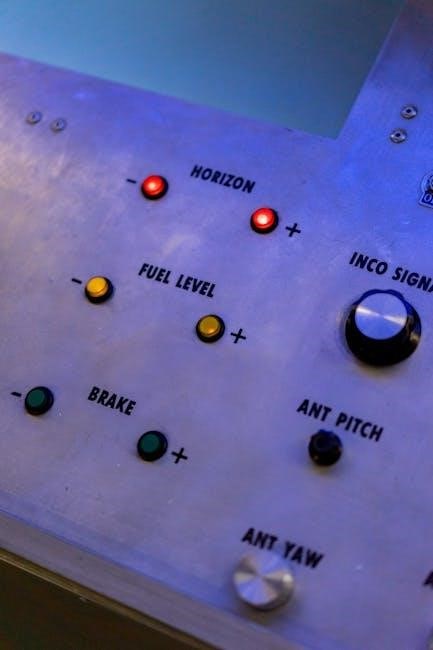Kaivac 1750 Parts Manual: A Comprehensive Guide
This manual details the Kaivac 1750 system, offering crucial parts information, diagrams, and manual codes like MANUAL1750․ It supports models 1750/2750,
KaiZen, and No-Touch cleaning systems․
The Kaivac 1750 represents a significant advancement in cleaning technology, designed for efficient and thorough facility maintenance․ This system isn’t merely a cleaning tool; it’s a comprehensive solution integrating vacuuming, rinsing, and solution delivery into a single, streamlined process․ Understanding its components and operation is vital for maximizing its performance and longevity․
This introduction serves as a foundational overview, preparing users to navigate the intricacies of the Kaivac 1750 and its associated parts․ Whether you’re a seasoned maintenance professional or new to the system, this guide will provide essential insights․ The Kaivac 1750 is often found in bustling environments, like the vibrant Mariahilfer Straße area, demanding robust and reliable cleaning solutions․ Proper maintenance, utilizing the correct replacement parts, ensures consistent operation and minimizes downtime․ Referencing the manual, specifically MANUAL1750, is crucial for optimal results․

Understanding the Kaivac 1750 System
The Kaivac 1750 system operates on a unique principle, combining multiple cleaning stages into one efficient process․ It’s more than just a vacuum; it’s a self-contained cleaning unit capable of dispensing cleaning solution, scrubbing surfaces, and simultaneously extracting dirty water․ This integrated approach minimizes cross-contamination and significantly reduces cleaning time․
Key to understanding the system is recognizing the interplay between its core components – the solution tanks, vacuum motor, and specialized nozzle assemblies․ Each part plays a critical role in achieving optimal cleaning results․ Regularly consulting the Kaivac 1750 parts manual, and codes like MANUAL1750, is essential for identifying and replacing worn or damaged components․ Like maintaining the stylish elaya hotel vienna city west, consistent upkeep ensures peak performance․ Familiarity with wiring diagrams (before SN 8000) and parts lists (RL1750, CSS08, JWW) is paramount for effective maintenance and repair․

Key Components and Parts
Kaivac 1750 relies on vital parts like nozzle assemblies, solution tanks, and vacuum motors․ Refer to the manual for diagrams and parts lists․
The 1750 Series Overview
The Kaivac 1750 series represents a significant advancement in cleaning technology, designed for efficient and thorough cleaning of various surfaces․ This system incorporates a unique spray-and-vac process, utilizing both cleaning solution and powerful vacuum suction simultaneously․ Understanding the core components is essential for effective maintenance and repair․

The series includes models like the 1750 and 2750, alongside specialized systems such as KaiZen and No-Touch Cleaning․ Each model shares fundamental parts, but may have unique configurations․ This manual provides detailed breakdowns of these variations․ Key features include robust construction, user-friendly operation, and a commitment to hygiene; Proper identification of parts, aided by detailed diagrams, is crucial for ensuring optimal performance and longevity of your Kaivac equipment․ Regular inspection and replacement of worn parts, as outlined in this guide, will minimize downtime and maximize cleaning effectiveness․
Essential Replacement Parts
Maintaining your Kaivac 1750 requires timely replacement of key components․ Essential parts include nozzle assemblies, which directly impact cleaning effectiveness, and solution tanks, ensuring consistent fluid delivery․ The vacuum motor and its associated components, like filters (225-0074), are critical for suction power․
Regularly inspect and replace wear items such as hoses, wands, and seals to prevent leaks and maintain optimal performance; Parts like the return line (RL1750) and U-nuts (CSS08) are frequently needed during maintenance․ Kaivac guarantees all replacement parts for 90 days from installation․ Utilizing genuine Kaivac parts ensures compatibility and upholds the system’s cleaning standards․ Refer to the parts lists (e․g․, JWW) and diagrams within this manual for accurate identification and ordering․
Nozzle Assemblies
Nozzle assemblies are fundamental to the Kaivac 1750’s cleaning process, directly impacting solution application and soil removal․ Different nozzle types cater to various surface types and cleaning tasks․ Regular inspection is crucial; check for wear, cracks, or blockages that diminish performance․
Replacement nozzles ensure consistent spray patterns and optimal cleaning results․ Consider the specific application when selecting a replacement – wider nozzles for large areas, focused nozzles for targeted cleaning․ Maintaining proper nozzle function prevents wasted solution and maximizes cleaning efficiency․ Refer to the Kaivac 1750 parts manual for detailed diagrams and part numbers․ Proper nozzle selection and maintenance contribute significantly to the longevity and effectiveness of your Kaivac system․ Ensure compatibility with your specific 1750 model․
Solution Tanks and Components
Solution tanks and their associated components are vital for delivering cleaning fluid effectively within the Kaivac 1750 system․ These components include fill caps, filters, lines, and pumps, all working in unison․ Inspect tanks regularly for cracks or leaks, and filters for clogs, to maintain optimal performance․
The Kaivac 1750 parts manual provides detailed schematics of these components, including part numbers for replacements like the RL1750 return line․ Proper maintenance prevents solution contamination and ensures consistent cleaning power․ Always use approved cleaning solutions to avoid damage to tank materials․ A functioning solution delivery system is paramount for achieving desired cleaning outcomes․ Refer to the manual for specific tank capacity and component specifications for your 1750 model․
Vacuum Motor and Components
The Kaivac 1750’s vacuum motor is the core of its powerful extraction capabilities․ Key components include the motor itself, fan assemblies, and associated housings․ Regular inspection of the motor brushes is crucial for longevity, as wear impacts suction performance․ The Kaivac 1750 parts manual details exploded views of these components, listing part numbers for replacements․
Maintaining a clean motor housing prevents overheating and ensures efficient operation․ Pay attention to any unusual noises, which could indicate bearing failure or debris obstruction․ The manual also outlines procedures for checking and replacing the HEPA filter assembly (225-0074), vital for capturing fine particles․ Proper vacuum function is essential for removing both liquids and solids, leaving surfaces thoroughly dry․ Always disconnect power before servicing the vacuum motor․

Locating Parts and Diagrams
Kaivac 1750 parts and diagrams are accessible through the official manual, including wiring diagrams (before SN 8000) and detailed parts lists (RL1750, CSS08, JWW)․
Accessing the Kaivac 1750 Parts Manual
Obtaining the Kaivac 1750 Parts Manual is a crucial first step for maintenance and repair․ Parish Supply offers access to Kaivac Operators Manual & Spare Parts List resources online, providing a convenient starting point for locating the necessary documentation․
Furthermore, Kaivac themselves likely provide direct access to the manual through their official website or upon request․ The manual, identified by code MANUAL1750, contains detailed schematics, exploded views, and comprehensive parts lists essential for identifying and ordering replacement components․
Ensure you have the correct manual version, as wiring diagrams differ before serial number 8000․ Utilizing these resources will streamline the process of understanding your Kaivac 1750 and ensuring its continued optimal performance․ Proper documentation is key to efficient upkeep․
Interpreting Wiring Diagrams (Before SN 8000)
Understanding the wiring diagrams for Kaivac 1750 units manufactured before serial number 8000 is critical for accurate repairs․ These earlier models utilize a different wiring configuration compared to later versions․ The parts manual, specifically MANUAL1750, provides these essential diagrams․
Carefully examine the diagram, noting the component labeling (e․g․, vacuum motor, solution pump) and wire colors․ Trace the connections meticulously to identify potential faults․ Pay close attention to grounding points and safety features․
Reference the accompanying parts list to confirm component identification․ Incorrect wiring can lead to malfunction or safety hazards․ If unsure, consult a qualified technician․ The diagram details RefNbr, Part Number, Description, and Notes for each component, aiding in accurate troubleshooting and repair․
Utilizing Parts Lists (e․g․, RL1750, CSS08, JWW)
Kaivac 1750 parts lists are fundamental for efficient maintenance and repair․ These lists, identified by codes like RL1750 (Return Line for 1750), CSS08 (5/16-18 U-Nut), and JWW, detail every component of the system․ The manual, MANUAL1750, incorporates these crucial resources․
Each entry includes a Part Number, detailed Description, Required quantity (Req), and any relevant Notes․ Use these codes when ordering replacement parts from authorized dealers or online suppliers․ Accurate identification prevents incorrect parts being shipped․
Cross-reference the parts list with the exploded diagrams to visually confirm component location and assembly․ This ensures correct installation and optimal performance․ Maintaining a current parts list is vital for long-term Kaivac 1750 operation․

Maintenance and Troubleshooting
Routine maintenance extends Kaivac 1750 life, while addressing common issues quickly minimizes downtime․ Refer to MANUAL1750 for detailed procedures and solutions․
Routine Maintenance Procedures
Regular upkeep of your Kaivac 1750 is vital for optimal performance and longevity․ Begin by inspecting the nozzle assemblies for wear and tear, replacing them as needed to maintain effective cleaning․ Solution tanks should be emptied and thoroughly cleaned after each use to prevent buildup and contamination․
The vacuum motor requires periodic filter checks and replacements – a clogged filter significantly reduces suction power․ Always consult MANUAL1750 for specific filter part numbers and replacement intervals․ Inspect hoses and connections for leaks or damage, ensuring a secure seal for efficient operation․
Pay close attention to the HEPA filter assembly (225-0074), replacing it according to the manufacturer’s recommendations․ Proper maintenance, guided by the parts manual, will minimize downtime and maximize the lifespan of your Kaivac equipment;
Common Issues and Solutions
Reduced suction is a frequent concern; often caused by a clogged HEPA filter (225-0074) or a full solution tank․ Inspect and replace the filter, and empty the tank․ Leaks in hoses or connections can diminish cleaning power – check all connections and replace damaged hoses using RL1750 return lines if necessary․
If the machine isn’t powering on, verify the power cord and check for tripped breakers․ Consult the wiring diagram (before SN 8000) within MANUAL1750 for electrical troubleshooting․ For issues with nozzle assemblies, ensure they are correctly attached and free from obstructions․
Remember, all Kaivac replacement parts carry a 90-day guarantee․ Refer to the parts manual for specific part numbers (like CSS08 U-nuts or JWW components) and detailed repair instructions․

Warranty Information
Kaivac guarantees all replacement parts for 90 days from installation․ This coverage ensures quality and reliability for your 1750 system repairs․
90-Day Guarantee on Replacement Parts
Kaivac stands firmly behind the quality and durability of all replacement parts offered for the 1750 series and other cleaning systems․ We provide a comprehensive 90-day guarantee, commencing from the date the part is installed and put into service․ This guarantee covers defects in materials and workmanship under normal operating conditions․
Should a replacement part fail within this 90-day period due to a manufacturing defect, Kaivac will, at its discretion, either repair or replace the faulty part free of charge․ This guarantee does not cover damage resulting from misuse, improper installation, neglect, or unauthorized modifications․
To initiate a warranty claim, please contact an Authorized Kaivac Dealer or Kaivac customer support, providing proof of purchase and a detailed description of the issue․ Maintaining records of installation dates is crucial for efficient claim processing․ This commitment reflects our dedication to customer satisfaction and the longevity of your Kaivac equipment․
Understanding Manual Codes (MANUAL1750)
Kaivac utilizes specific manual codes to streamline identification and access to the correct documentation for each product series․ MANUAL1750, as the code explicitly indicates, is designated for the 1750 series cleaning systems, encompassing operators manuals, spare parts lists, and related technical information․
These codes ensure that users, technicians, and dealers can quickly locate the precise manual required for troubleshooting, maintenance, or parts ordering․ Referencing the manual code when contacting Kaivac customer support or searching online parts suppliers significantly accelerates the process of obtaining the necessary resources․
Other relevant codes, such as those associated with specific parts lists (RL1750, CSS08, JWW) further refine the search for detailed component information․ Understanding and utilizing these codes is essential for efficient Kaivac equipment management and maintaining optimal performance․

Where to Purchase Parts
Kaivac replacement parts are available through authorized Kaivac dealers and various online parts suppliers, ensuring convenient access to components․
Authorized Kaivac Dealers
Locating an authorized Kaivac dealer provides direct access to genuine Kaivac 1750 parts and expert support․ These dealers possess in-depth knowledge of the Kaivac system, ensuring you receive the correct components for your specific model – whether it’s a 1750, 2750, KaiZen, or No-Touch cleaning system․
Authorized dealers can assist with identifying parts using manuals, parts lists (like RL1750, CSS08, or JWW), and even wiring diagrams (particularly important for units before serial number 8000)․ They offer a reliable source for essential replacement parts, including nozzle assemblies, solution tank components, and vacuum motor parts․
Furthermore, authorized dealers often provide valuable maintenance advice and troubleshooting assistance, maximizing the lifespan and performance of your Kaivac 1750․ They stand behind the 90-day guarantee on all replacement parts, offering peace of mind with your purchase․
Online Parts Suppliers
Several online suppliers offer Kaivac 1750 parts, providing a convenient alternative to traditional dealers․ When sourcing parts online, verifying authenticity and compatibility is crucial, especially considering variations within the 1750 series (including 1750/2750, KaiZen, and No-Touch models)․
Ensure the supplier offers detailed parts lists – referencing codes like RL1750, CSS08, and JWW – and ideally, access to the Kaivac 1750 parts manual or relevant diagrams․ Pay close attention to wiring diagrams if your unit’s serial number is before 8000, as these can differ․
Confirm the supplier honors the 90-day guarantee on replacement parts, mirroring the policy of authorized Kaivac dealers․ Look for clear return policies and customer support options․ Carefully review product descriptions to ensure you’re ordering the correct nozzle assemblies, solution tank components, or vacuum motor parts for your specific needs․

Safety Precautions
Always disconnect power before handling replacement parts․ Operate the Kaivac 1750 safely, following the manual, and wear appropriate protection during maintenance․
Operating the Kaivac 1750 Safely

Prioritize safety when utilizing the Kaivac 1750․ Always ensure the machine is powered off and disconnected from the electrical source before performing any maintenance or parts replacement․ Familiarize yourself thoroughly with the operator’s manual, paying close attention to all warnings and instructions․
Never operate the Kaivac 1750 with damaged or missing parts; promptly replace them with genuine Kaivac components․ Avoid directing the spray nozzle towards yourself or others․ Wear appropriate personal protective equipment, including eye protection and gloves, during operation and cleaning․
Be mindful of the surrounding environment, ensuring adequate ventilation and preventing contact with flammable materials․ Inspect the machine regularly for any signs of wear or damage․ Proper training and adherence to safety guidelines are essential for preventing accidents and maintaining a safe working environment․ Refer to MANUAL1750 for detailed safety information․
Handling Replacement Parts
Genuine Kaivac replacement parts are crucial for maintaining the 1750’s performance and warranty validity․ Always verify the part number against the parts manual (MANUAL1750) before installation, utilizing parts lists like RL1750, CSS08, or JWW for accurate identification․
Store parts in a clean, dry environment, protected from extreme temperatures and direct sunlight․ Handle delicate components, such as nozzle assemblies or HEPA filters, with care to avoid damage․ Dispose of used parts responsibly, following local regulations․
Kaivac guarantees all replacement parts for 90 days from the installation date․ Retain proof of purchase for warranty claims․ Incorrect installation or use of non-genuine parts may void the warranty․ Refer to the diagrams within the manual for proper placement and assembly of each component․


























































































